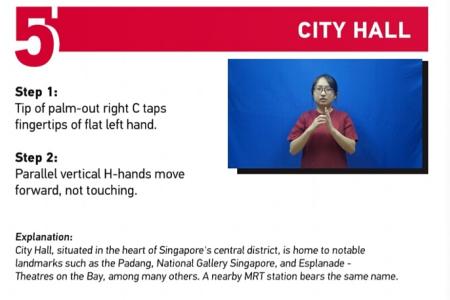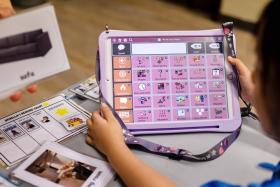S'pore Sign Language e-book helps raise visibility of local signing
Have you ever wondered how to say “So shiok!” or “City Hall MRT station” in sign language?
Local signing is now available to all to learn for free with the launch of an e-book on the Singapore Sign Language (SgSL) in September.
The free e-book, developed by Nanyang Technological University (NTU) and the Singapore Association for the Deaf (SADeaf), is among the latest efforts to boost knowledge of the local sign language and raise its visibility here.
It is an introduction to SgSL and its significance, containing common words and uniquely Singaporean terms used in everyday conversation, with GIFs, or looping animations, to illustrate how to sign it.
SADeaf previously worked with linguistic students from NTU to start an online SgSL sign bank, which documents signs used within the deaf community. It now has 749 signs, up from 50 in 2018.
NTU’s Centre for Modern Languages began offering SgSL elective classes in 2015, and receives an average of 200 students yearly.
In 2023, SADeaf had more than 3,000 members of the public, both deaf and hearing, learn sign language in their classes.
SgSL developed organically within the deaf community over several decades, going back to the 1950s with the establishment of the Singapore Chinese Sign School for the Deaf, said executive director of SADeaf Josh Lye.
Since then, deaf Singaporeans have adapted and created signs that reflect their daily experiences, local culture, and multilingual environment, he said.
“It is a distinct language that embodies the cultural identity of the Deaf community in Singapore,” he added.
Deaf, with a capital D, refers to people with hearing loss who use sign language as their preferred communication mode, and identify as members of the Deaf community. The term deaf, with a lowercase D, is a general term used to describe people with hearing loss of varying degrees, regardless of their communication mode.
Associate Professor Ng Bee Chin, who is associate dean at NTU’s College of Humanities, Arts and Social Sciences, said: “When a hearing parent of a Deaf child first discovers that the child is deaf, the most critical issue is to make sure that the child continues to receive language input.
“Hence, the sign bank was started as a way to bring essential signs to the public so that they can learn about basic signs for essential communication. Over time, we hope for the sign bank to develop into a standard reference guide for the use of SgSL.”
Many members of the local deaf community have been pushing for SgSL to be recognised as Singapore’s official sign language for years.
The Ministry of Social and Family Development embarked on a study in September 2023 on whether to turn the local sign language into a national one. There have been no updates on this since then.
Mr Lye told The Straits Times that official recognition would validate SgSL as a legitimate language and be a significant milestone towards inclusion and full participation for deaf individuals in Singapore’s society.
Some Asean countries have recognised their national sign languages.
Malaysia recognised Bahasa Isyarat Malaysia, or Malaysian Sign Language, under its Persons with Disabilities Act of 2008, and the Philippines officially recognised Filipino Sign Language in 2018.
Mr Lye said having a local sign language fosters a stronger sense of belonging and pride as it allows deaf individuals to express themselves in a language that resonates with their personal experiences, and ensures cultural nuances are accurately conveyed.
“Moreover, it promotes inclusivity by bridging communication gaps between the Deaf and hearing communities through a shared understanding of local culture,” he added.
“With over 300 sign languages in the world, it’s clear that the desire for a local language that resonates with the local community is widespread.”
Get The New Paper on your phone with the free TNP app. Download from the Apple App Store or Google Play Store now


